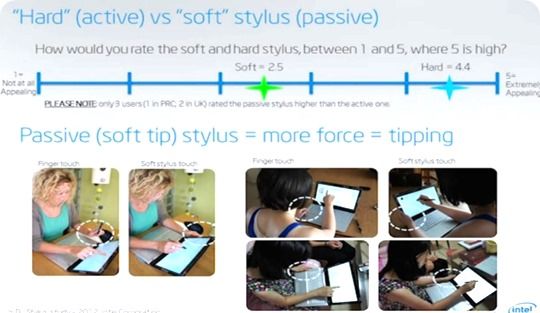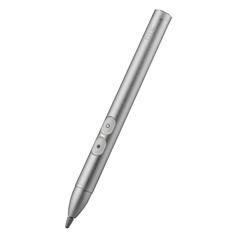Intel have just published the results of a study into the use of a digitizer and stylus on an Ultrabook.
Those of you that were into tablets in the mid 2000’s will know that Windows TabletPCs were very much stylus-oriented. Windows XP Tablet Edition included support for handwriting and the now-missing TIP, a floating input panel that would appear when an input box was selected. The digitizer was not only good for natural input but also for detecting and using something that many people forget when moving to finger touch – the hover action. Hovering meant you could activate contextual features and, simply put, see where you were putting the pointer. Over the last 10 years the finger-optimised touch layer has taken over and user interfaces have moved along to allow the finger to be used as the pointer but Windows 8 still supports handwriting input and there are still a number of important use-cases for the pen.
Intel’s study addresses the user-experience aspects of using a stylus on a clamshell device by sitting down and discussing the desires and issues with a global audience. The study also helps to strengthen some previous study findings around touchscreens, keyboards and touchpads. For example, Intel found that 56% of people asked wanted touch and a stylus on their ideal laptop. 22% of people said they don’t want a touchpad at all!
In part one of the three-part video you’ll see how Intel performed the study and hear about some the high-level results presented by Daria Loi, User Experience Innovation Manager at Intel.
A post entitle “Pointing the Way” is also available and there’s a touchscreen UX guide available.
Unfortunately Intel have removed the videos that were originally included in this article. We’ve tracked down the original Web articles and they’re listed below.
- The Human Touch: Building Ultrabook™ Applications in a Post-PC Age presents Intel research that investigates which application characteristics create the most compelling user experiences on Ultrabook devices.
- User Interface Design Guidelines for Great Experience Design introduces considerations for developers as they produce UIs that deliver outstanding user experiences.
- Adding Touch Support to Desktop Applications for Ultrabook™ Running on Windows* 8 provides hands-on coding instructions that demonstrate how to touch-enable an application UI.
- Developing Power Efficient Desktop Applications for Ultrabook™ on Windows* 8 is a developer how-to article with in-depth examination of techniques for power-related coding in .NET.
- Re-imagining Apps for Ultrabook™ series offers new ways of thinking and practical design advice that can help fuel innovation at software companies as they explore the new opportunities for Ultrabook devices.
What do users want a stylus for?

The study found that precision is important for users and the stylus is a barrier-free way to achieve it. Clean screens, intimate relationships with the pen and an aspect of personality plays a role too. Writing a hand-written electronic birthday card is mentioned. There’s a series of use-cases that are highlighted in the report.
In Part three you’ll learn more about the findings along with recommendations for designers and manufacturers. This section is also important for app developers. Intel recommends that software developers think about the following aspects:
- The use of a stylus is a very personal experience for many people.
- Think about unsavvy users.
- Mobile usage is important.
- Think about optimising the web experience for stylus users. E.g. submenus and right clicks
- Users want to be able to use digital signatures.
- Think about the precision-level available with the stylus in relation to editing images and videos.
- Collaboration and sharing is an important area for users.
- Think about palm detection and rejection.
And finally, here’s my thought. How about adding a tiny infra-red transmitter into the stylus so it can be used for highly accurate air-gestures or air-writing when used with the perceptual computing hardware? I can think of some great applications there.
My personal experience with digitizers is that I tended to use the feature for annotation rather than creation and that after a period of time I got a big advantage from hover detection and contextual menus. I’m not a great handwriter though so that might have something to do with why I never got any advantage from handwriting input.
What’s your experience with digitizers? What would you like to see? How could it combine with some of the convertible solutions?T
I’ve made a video about Ultrabook touch scenarios as a demonstration. You can watch it below.












Again a great article! Thank you!
Can you ask Daria, why the buying interest much higher in Poland and China than in the US.
Developing / selling a touch / pen oriented business solution, in the last three years I analyzed all current and future touch / pen / interactive technologies what you can imagine. Some experiences from my side for you and Daria:
– If I use an application where I definitely need pen in a part, then I will use the pen always because putting down and picking up the pen all the time is annoying.
– Some of my users bought the product for hell a lot of money and do not use it because they say, the friction of the stylus is lower than the friction of a normal pen on a normal paper.
– To air-writing:
1. If you need a camera to detect the infra, then the camera can detect also a specially colored tip, so that you do not need battery in the stylus.
2. To my experience air-writing does not work because you either have to push / release a button all the time at pen up / down or you have to detect it somehow. In the latter case you will still miss a lot the tactile feedback and it would also be very tiring.
I am a real estate agent, and even though we can use “point and click” solutions like Docusign for digital signatures, I prefer the pen.
Also, I’d love to be able to take notes on a decent sized tablet. I don’t know why everyone wants tiny little hybrids, with unreadable screens and unusable keyboards that make everyone look like Andre the Giant. And if I hear another adult whine about holding 2 lbs like it was a 50 lb sack of potatos I”m going to barf. If the 13″ Asus Transformer Book came with a digitizer, I’d pay a princely sum (over 2K in fact). Looks like it won’t have a digitizer, and is looking more and more like it’s not even going to make it to production.
Spot on. Exactly what I’m thinking. I will NOT buy a tablet without onenote and wacom active digitizer. I don’t need a toy, I need a productivity tool. So big screen real estate and prime quality digital inking are vital. I was also setting for Asus Transformer Book – until it became clear it won’t have a wacom pen. Near perfect hybrid, but no pen = no money for Asus.
Thanks for the valuable feedback Quinn, hez.
I bought Galaxy Note (first smartphone) because of the digitizer and stylus. I thought, that not many people liked a stylus (ok probably Steve Jobs made me think so?). Any way, now I see that many people like touch and stylus. That’s good. I am waiting for a good ultrabook convertible with touch and digitizer and Haswell-Chip and Windows 8. In the meantime I bought a Note 10.1 with stylus to take notes and annotate pdfs. So, developpers: when I am going to buy my first Windows 8 touch/stylus device, i would like to see good apps for that!
Don’t worry that app already exists.
well, just one note to this: what is really new, what was not claimed for almost decades now from the industry? i get the impression that if somebody does not want something to do/realize he either sets uo a committee or he does numerous so called studies ……. we know this stuff long time – so do it, stop talking.
one simple example: the good old psion 5 or hp jornada palmtops had it all in a almost perfect design (except that touchscreen tech was not so far developed yet). the layout of screen and keyboard was arranged so, that you could type easyly while holding your stylus and using it as a mouse or for writing and drawing on the screen.
just forget to mention that microsoft self developed 2 of the best applications for integrated word together with a stylus : journal and one note, the most powerful and versatile applications – beside drawing, illustration, cad programs – for integrated work with a stylus. but they keep their mouths shut about that, sp people do not really know. the same was the case with an integrated stylus application on the first netbook convertibles for kids. these devices came with a perfect killer application for stylus use integrating every aspect of school work (very useful for managers too btw). this was killed by microsoft after leaving win xp!!! and vanished completely from its websites. btw another such application is powerpoint, a program far more powerful if used together with a stylus, where ms does not talk about the hidden treasures within since it came to market. ad these are only a few of such examples
You are so right. Which just proves.. look, I don’t really know how to put it in a diplomatic way, so I’ll just say it – Microsoft marketing people are mostly blind sheep idiots. They’re just following up, with a 2-3 year lag, trying to ride the big wave.. No vision whatsoever. You change live tiles in WP8 to icons and you get an iOS. I’ll just give a plus to the xbox team for kinect… It’s like the only person who actually knew what would sell was Steve Jobs. But he was all too prejudiced toward the stylus. I don’t see anyone in Microsoft or even Apple itself, to have the slightest idea what to do next, it’s like all they come up with is putting touchscreens and retinas everywhere they can. Why, why they don’t see the stylus for the revolution it could be. A decent windows based tablet with a stylus gives you a paperless life, and that’s a waaay bigger thing than an ipad. Where is my digital notebook?! Man, it’s irritating.